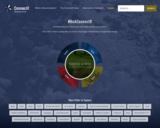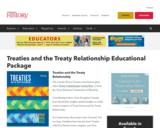
An overview on the 4 sacred medicines of First Nations peoples.
- Subject:
- Agriculture Production
- Agriculture Studies
- Material Type:
- Open Access Asset
- Author:
- TN
- Date Added:
- 04/12/2024

This collection features lessons and units for FNME.

An overview on the 4 sacred medicines of First Nations peoples.

Aboriginal Literatures in Canada: A Teacher’s Resource Guide serves a double purpose: to encourage the teaching of Aboriginal literature in English high school curricula across the country because Aboriginal students deserve to be taught texts they can relate to and, because non-Aboriginal students should be educated about Aboriginal culture, history and contemporary life through the richness of Aboriginal writing with its innovative uses of the English language. Various works of Aboriginal literature are included.

Indigenous Peoples have indicated that financial education is a priority for them and complements other training programs in their communities. . To be successful, financial literacy interventions must be community driven, created by and for Indigenous Peoples. These videos and activities allow students to explore the story of a social entrepreneur and leader who values financial literacy and gives back through his business to help his Indigenous community create a better tomorrow.First Nations entrepreneur Mark Marsolais-Nahwegahbow works hard to ensure his family’s financial wellness while making a real impact on his community. He founded a social enterprise that brings fresh drinking water to Indigenous families across Canada. https://www.youtube.com/watch?v=0A-6JzC0IcwThe activities include multiple choice, vocabulary, short answer and open ended questions giving the students an opportunity to review advice on being an entrepreneur, giving back to your community and providing for your family and future.

This is a database of lessons and units searchable by content and cultural standards, cultural region and grade level.
Included are lessons and units on:
Whouy Sze Kuinalth - "Teaching Our Many Grandchildren"
Tauhna Cauyalitahtug - (To Make a Drum)
Math Story Problems
St. Lawrence Island Rain Parka
Winds and Weather
Willow
Driftwood
Snowshoes
Moose
Plants of the Tundra
Animal Classification for Yup'ik Region
Rabbit Snaring
The Right Tool for the Job - Fishing Tools and Technology
Blackfish
Family Tree
Medicinal Plants of the Kodiak Alutiiq Archipelago
Beaver in Interior Alaska
Digging and Preparing Spruce Roots
Moose in Interior Alaska
Birds Around the Village
Dog Salmon
This site also has the "Handbook for Culturally Responsive Science Curriculum".

Rita Claire teaches us about the importance of Inuit clothing and how it protects against the cold. Rita Claire and Celina Kalluk perform a throat song together, and we read the book Viivi’s New Kamik.

ConnectR is an online tool created to inspire Reconciliation in Canada.
ConnectR helps you choose your next steps towards reconciliation.
Find calls to action to grow what you know, encourage a shared future and generate change.

The Buffalo: A Treaty of Co-operation, Renewal and Restoration.
This site offers the history of this Treaty, the relationships it involves, related films and news articles and access to the Buffalo Treaty blog.

This video explores the return of buffalo through First Nations sharing and gifts. This is a great resource when exploring Indigenous agriculture and the impact of settlement on Indigenous agriculture.

Haida Art-Indigenous Art
Math Colour By Number
Sums 9-16
Bunny
By Allan Weir, Haida
NativeNorthwest.com

Students use washable paints, markers, and construction paper to illustrate a month from the traditional Cree Calendar
Students will be able to:
illustrate a month from the traditional Cree calendar;
demonstrate an understanding of the changes, cycles and patterns that occur in nature through words and images;
draw/paint geometric and organic shapes;
create the illusion of depth in space using size;
connect personal life experiences to their artworks.

In 2008, a group called the Truth and Reconciliation Commission (TRC) was made. Their job was to listen
to stories about residential schools and then write the stories down so we can learn from our mistakes.
In 2015, the Truth and Reconciliation Commission announced their 94 Calls to Action. These are 94
activities all governments, courts, businesses, schools, and people living in Canada can do to help fix the
mistakes of the past and present so that all children – including First Nations, Métis, and Inuit children –
can grow up happy, healthy, safe, and proud of who they are.
This booklet is written by Spirit Bear as a youth-guide to the TRC’s 94 Calls to Action. Each of the calls is outlined in student-friendly language that will give them a deeper understanding of Truth and Reconciliation process.

Applicable for Grades 3–6 and Grades 7–12.
The lesson plans in Treaties and the Treaty Relationship: Educator’s Guide are framed on the Historical Thinking Concepts and offer teachers interactive instructional approaches that foster engaged student inquiry. They are fortified with maps, weblinks, and supporting Blackline Masters.
Lesson plan themes explore Treaties across Canada from time immemorial to the present, making a concerted link between the past and the future.
As well, each learning activity offers adaptions and/or activities based on the lesson theme for exploring Treaties in grades three to six.
It is with the greatest appreciation that we thank the many contributors and supporters of the Treaties and Treaty Relationship: Educator’s Guide.
Go to the website to download the pdf package.

Canadian art is a door to learning about a wide range of subjects.
The Art Canada Institute teacher resource guides presented here offer students the opportunity to study a multitude of subjects—from environmental awareness to activism, social justice to gender studies, politics to computer science (to name a few)—through the art and artists who have defined this country’s visual culture.
Following our provinces’ education curricula, the teacher resource guides provide multidisciplinary learning activities that reveal how Canadian art powerfully reflects our world so we can better understand it.
Activities for K-12!

An inquiry-based project to map the land in your community. The key concepts in this unit are grounded in Indigenous beliefs of interconnectedness, connectedness, and respect for all things.
The driving inquiry questions for this unit are:
1. How can respect for the land be shown?
2. What do we look for when setting up a camp?
3. What stories or teachings are connected to key locations in and around our community?
4. How has the land around our community changed over time?
5. Who do we share our community’s lands with?

This site provides lessons developed to help students understand the Inuit culture.
Lesson 1
- Lesson Question: How do Inuit on Baffin Island live, and how does Arctic life resemble and differ from ours?
Lesson 2
- Lesson Question: What can Inuit life on Baffin Island teach us?
Lesson 3-4
- Lesson Question: How does a short book about the Arctic (such as Michael Arvaarluk Kusugak's NORTHERN LIGHTS: THE SOCCER TRAILS or his BASEBALL BATS FOR CHRISTMAS, both from Annick Press, Buffalo, NY) illustrate Inuit life, social interaction, and environments?
Lesson 5
- Lesson Question: How does Inuit culture reflect beliefs, issues, and events relevant to societies past and present?
Lesson 6
- Lesson Question: How does Inuit culture compare to my own culture?

Cree Code Talker reveals the role of Canadian Cree code talker Charles ‘Checker’ Tomkins during the Second World War. Digging deep into the US archives it depicts the true story of Charles’ involvement with the US Air Force and the development of the code talkers communication system, which was used to transmit crucial military communications, using the Cree language as a vital secret weapon in combat.

In this lesson, students will expand their knowledge and dive deeper into lesser-known Indigenous histories in Canada, particularly those of Second World War Cree Code Talkers. Students will then be asked to summarize and compare both histories.
What are Cree Code Talkers? What was their purpose?
During the Second World War, encryption and coded messages were deemed essential to winning the war. Utilizing Cree, the government relied on Indigenous men to use their language to aid the war effort; these men were known as Cree Code Talkers.

This YouTube channel is full of many supports for teaching Cree. It allows the learner to hear the language in context. The channel provides pronunciations and structures to help you move forward and learn on your own!

Provided by the Government of Saskatchewan to the University of Regina, this is a Cree Language Learning resource that one can download and use for free.
The comprehensive resource includes chapters on dialects, many grammatical topics, expressions, vocabulary and much more.

From October 17th to 22nd, we observe Secret Path Week, an annual event dedicated to honoring the legacies of Gord Downie and Chanie Wenjack. These dates mark the anniversaries of Gord Downie’s and Chanie Wenjack’s entering the spirit world. Chanie, only 12 years old, fled from Cecilia Jeffrey Residential School in Kenora, Ontario, and walked along the train tracks for 36 hours before succumbing to exposure on October 22. Although Chanie is no longer with us, his story lives on through Gord Downie’s album Secret Path.
Join us virtually to learn directly from Indigenous artists, scientists, musicians, writers and more!
Watch Live or Watch Later
Camera Spot
Call In
Write In